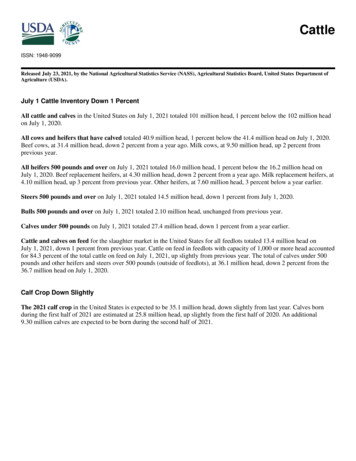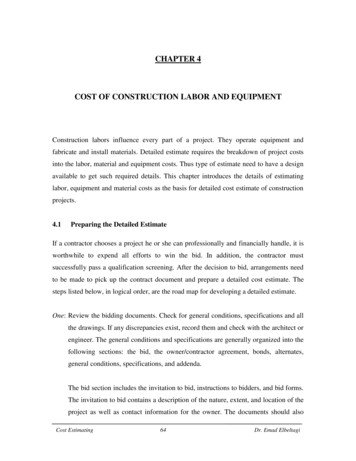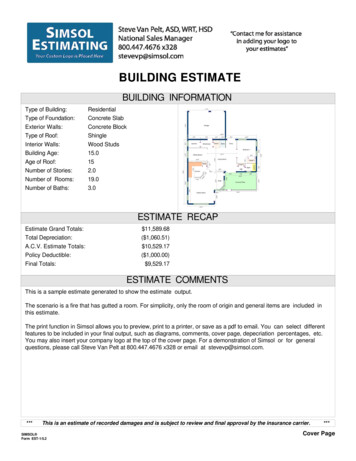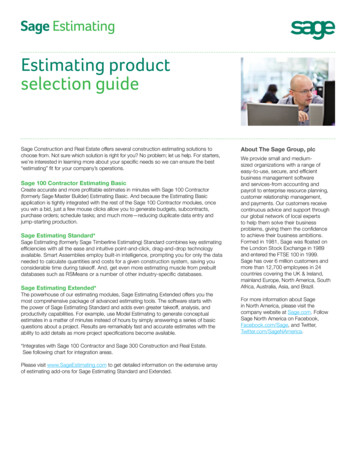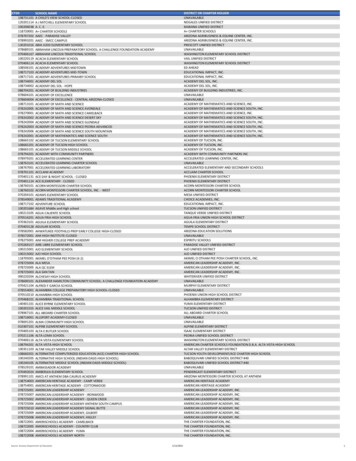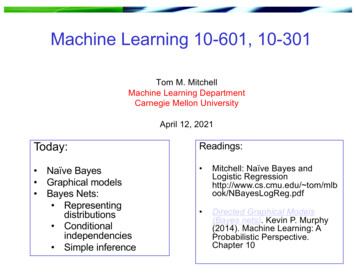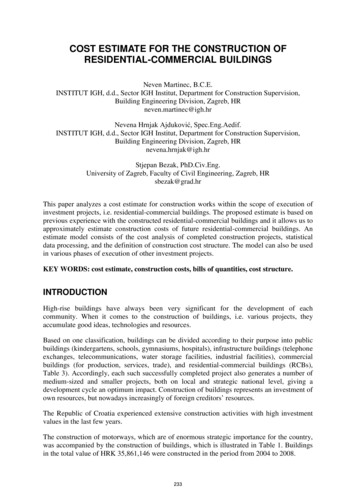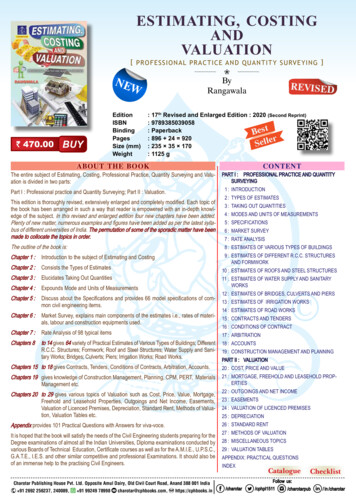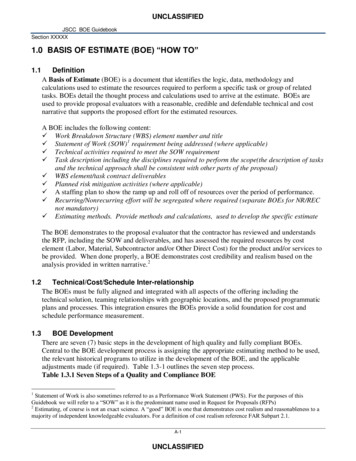
Transcription
UNCLASSIFIEDJSCC BOE GuidebookSection XXXXX1.0 BASIS OF ESTIMATE (BOE) “HOW TO”1.1DefinitionA Basis of Estimate (BOE) is a document that identifies the logic, data, methodology andcalculations used to estimate the resources required to perform a specific task or group of relatedtasks. BOEs detail the thought process and calculations used to arrive at the estimate. BOEs areused to provide proposal evaluators with a reasonable, credible and defendable technical and costnarrative that supports the proposed effort for the estimated resources.A BOE includes the following content: Work Breakdown Structure (WBS) element number and title Statement of Work (SOW) 1 requirement being addressed (where applicable) Technical activities required to meet the SOW requirement Task description including the disciplines required to perform the scope(the description of tasksand the technical approach shall be consistent with other parts of the proposal) WBS element/task contract deliverables Planned risk mitigation activities (where applicable) A staffing plan to show the ramp up and roll off of resources over the period of performance. Recurring/Nonrecurring effort will be segregated where required (separate BOEs for NR/RECnot mandatory) Estimating methods. Provide methods and calculations, used to develop the specific estimateThe BOE demonstrates to the proposal evaluator that the contractor has reviewed and understandsthe RFP, including the SOW and deliverables, and has assessed the required resources by costelement (Labor, Material, Subcontractor and/or Other Direct Cost) for the product and/or services tobe provided. When done properly, a BOE demonstrates cost credibility and realism based on theanalysis provided in written narrative. 21.2Technical/Cost/Schedule Inter-relationshipThe BOEs must be fully aligned and integrated with all aspects of the offering including thetechnical solution, teaming relationships with geographic locations, and the proposed programmaticplans and processes. This integration ensures the BOEs provide a solid foundation for cost andschedule performance measurement.1.3BOE DevelopmentThere are seven (7) basic steps in the development of high quality and fully compliant BOEs.Central to the BOE development process is assigning the appropriate estimating method to be used,the relevant historical programs to utilize in the development of the BOE, and the applicableadjustments made (if required). Table 1.3-1 outlines the seven step process.Table 1.3.1 Seven Steps of a Quality and Compliance BOE1Statement of Work is also sometimes referred to as a Performance Work Statement (PWS). For the purposes of thisGuidebook we will refer to a “SOW” as it is the predominant name used in Request for Proposals (RFPs)2Estimating, of course is not an exact science. A “good” BOE is one that demonstrates cost realism and reasonableness to amajority of independent knowledgeable evaluators. For a definition of cost realism reference FAR Subpart 2.1.A-1UNCLASSIFIED
UNCLASSIFIEDJSCC BOE GuidebookSection XXXXX The time and resources invested in each step will vary fromone BOE to another but all stages are important indeveloping a compliant BOE of high quality.Step 7Document theProcess and ResultsStep 6Timephase theEstimateStep 5Develop theResource EstimateStep 4Select theAppropriateEstimating MethodStep 3Determine the Scopeof Effort to EstimateNOStep 2Develop theExecution PlanStep 1Plan theDevelopment of theEstimate Effort andScheduleSpanCorrelate?YESBOE Tips & TricksKeep your BOE concise for the evaluator to understand and evaluateStart with actual data from completed programs and adjust appropriatelyas warranted with appropriate justification and rationaleMinimize the use of engineering judgment whenever possible1.3.1 Plan the Development of the EstimateTo develop a high quality and compliant BOE, it is important to determine the availability ofrelevant historical data and analyze applicable historical data for potential incorporation into theBOE. In addition, continuous validation of the integration of other proposal products is required (i.e.programmatic and technical baseline, IMP/IMS, etc). Ensuring that required processes and tools areavailable to the BOE team early in the proposal process is mandatory for success. Estimateorganization (including BOE product prerequisites), a well defined scope of work, and methodologydevelopment planning enable high quality and fully compliant BOEs.Use the following check list during the planning stage to ensure proposal compliance andintegration Estimate Organization and BOE Prerequisiteso WBS Structure and Dictionary - Review and or/develop the WBS and an (OrganizationalBreakdown Structure) OBS – WBS should be developed in accordance with MIL-STD881C, OBS is company uniqueo CLIN structure - Review CLIN cost accountability requirements (if required)o Request for Proposal (RFP) Program overview, specifications, system availabilityrequirements, schedule constraints, etc.o Ground rules and assumptions – generate the underlying assumptions required for yourestimate to be validA-2UNCLASSIFIED
UNCLASSIFIEDJSCC BOE GuidebookSection XXXXXoResponsibility Assignment Matrix - Develop a Proposal Responsibility Assignment Matrix(RAM), providing a full accounting of tasks, deliverables, and responsible parties Integrated Master Plan (IMP) and Integrated Master Schedule (IMS) or Program Schedule Develop hierarchy of program events and the schedule (IMP/IMS)Scope of Effort Estimateddepicting vertical traceability from Master Schedule and horizontal relationships between alldependent tasks.o Buying customer, prime contractor, and all subordinate subcontractor schedules are inconcert with the requirements contained in the highest-level master scheduleo Statement of Work (SOW) / Statement of Objectives (SOO) / Technical RequirementsDocument (TRD), etc. as applicableo Contract Data Requirements List (CDRL)o Government Furnished Properties/Items (GFP/GFI) - Review GFP/GFIo Deliverables - Product and/or Services to be provided Estimating Development Supporto Identify relevant past performance programs that can be used for historical data, technicaland programmatic attributes, or metrics that support cost credibility and realism anddevelopment of applicable estimate attributeso Identify and present any unique Strategies, Value Propositions (VPs), processimprovements, and/or cost efficiencies that are not present in historical data and driveaffordabilityo Provide a Basis for the Proposed Labor Skill Mix (include a Labor Category Dictionarywith the proposal)1.3.2 Develop the Execution PlanEarly and sufficient planning is critical to success. Identifying and generating the requisite referencematerials and identification of specific proposal requirements reduces re-work, prevents scheduledelays, and ensures availability of the required resources and tools. Early communication withcognizant proposal and functional personnel can aid in building a BOE team early and is critical forsuccess.1.3.3 Determine the Scope of Effort to EstimateThe scope of work estimated including program planning, scheduling, WBS/OBS, CLIN and otherorganizational elements must all be fully integrated. The BOEs must be fully aligned and linkedwith all aspects of the offering.1.3.4 Select the Appropriate Estimating MethodSelection of an appropriate estimating method (Analogy, Cost Estimating Relationship (CER), CostModels, Level of Effort, Engineering Judgment or Task Based) begins with the type and availabilityof data to support the estimate. Consider that a well supported data-driven estimate utilizes verifiableinformation traceable to approved Business Systems (e.g. Accounting System, Procurement System,Time Keeping System, etc.) and applies adjustments as warranted with appropriate, concise, andcomplete justification and rationale. Table 1.3.4.1 defines the estimating methods and the minimuminformation required for each one.A-3UNCLASSIFIED
UNCLASSIFIEDJSCC BOE GuidebookSection XXXXXTable 1.3.4.1 Estimating Method RequirementsAnalogyCostEstimatingRelationship(CER) Analogy is an estimate derived from the historical actual cost/hours of asimilar system/subsystem/end item. Factors may be applied for scope,technical and programmatic differences. Identify the analogous program that has already been completed and why itis relevant to the same or similar task estimate. Include the relevant projectname, project/contract number, period of performance, and task definition Describe the CWBS element from which the analogous historical data isderived and make a subjective evaluation and identification of thedifferences between the new system and historical system(s). The hours andcost impact of the technical differences must be identified. Describe a clear trace to how the analogous data was used to derive thecurrent estimate. This method is appropriate very early in the program life cycle when thesystem is not yet fully defined. A CER estimate is based on relevant historical, statistically correlatedrelationships. The mathematical equation represents the statisticalrelationship between independent and dependent variables of historical data.An assessment defines the degree of similarity, enabling the estimator todevelop comparative values (e.g. hours per drawing design). Percentagerelationships, which are also a form of a CER, are based on cost history, theresults crosschecked with similar programs, and a graph or a table backs upthe percent relationship in the BOE to show the proportion of therelationship. Identify the base (i.e. independent variables) to which the CER is applied.Describe the database used to create the CER and provide the relevantstatistics, such as mean and standard deviation of independent variables,number of data points, data range, standard error of the CER, R 2, t-statistics,F-statistic, and prediction intervals. List the equation, input variables used for the estimate, and the output valuecalculated. If any discrete adjustments are made to the output value, describe andprovide rationale for the adjustment and the resultant estimate. Annotate if the CER is reviewed and approved by DCMA or anothergovernment agency. If the CER is published or provided by another organization, identify thesource. Contractor in-house CERs will be documented and provided as partof the proposal.A-4UNCLASSIFIED
UNCLASSIFIEDJSCC BOE GuidebookSection XXXXXCost ModelLevel of EffortEngineeringJudgment A Cost Model is a mathematical compilation of one or many estimatingtechniques that derives project cost or effort from attributes/metrics of thesubject project. Examples of project metrics include weight, power,complexity, quantity, source lines of code (SLOC), and COTS productcharacteristics. The measurement is based on the technical, physical, orother end item characterictics. Cost Models may be internally developed orcommercially available. State the cost model used and describe the appropriateness of the model. Include the name of the model and version number. List the types and values of primary model input parameters used for theestimate. Describe the method in which the model was calibrated and validated usinghistorical company data. Provide the model output and relate it to the proposed resource estimate. Cost estimates using models shall be broken into labor, materials,subcontract and other direct cost elements using reasonable and supportableallocation techniques, if applicable. Labor costs shall be further broken outinto equivalent labor hours using reasonable and supportable labor rates. This method is appropriate early in the program life cycle when detailedspecifications are not available, but a database of like systems, performancespecifications and costs is available. This method often serves as a usefulcheck of an estimate made using another method. Level of Effort is an estimate based on identifying resource requirements tosupport specific identified tasks that are often based on a predeterminedlevel of support for a given period of time. This estimate type is minimallyaffected by product scope and/or quantity changes. Include allocation of personnel by account to cover specific tasks for a predetermined length of time. Provide rationale for period of performance. Use appropriate Manpower Conversion Factor (MCF) such as hours permonth, hours per day, hours per shift. Engineering Judgment is an estimate based on subject matter expertexperience with no specific relevant historical actual cost/hours identified.The subject matter expert develops the estimate based on the productdescription and tasks and operations required to be performed by theresponsible department to manufacture/produce the product. Provide a detailed explanation of the basis of the engineering judgment. Include the qualifications of the individual making the judgment.A-5UNCLASSIFIED
UNCLASSIFIEDJSCC BOE GuidebookSection XXXXXTask Based Be specific and detailed enough to demonstrate to an evaluator that theindividual is qualified to make this estimate. Most often used late in the development or early in the production phases.This technique encourages the contractor to do his homework early on anddefine all work down to the lowest level of the WBS. It is also a greatprocess control technique at the production facility. Task Based is an estimate developed at the lowest level of the WBS (at thedetail, sub-assembly and assembly levels) based on a standard and/orhistorical performance of accomplishing comparable tasks. The direct labor hours required to complete the work are estimated fromengineering drawings and specifications, usually by an industrial engineerusing company or general industry standards. The engineers may alsoestimate raw materials and purchase parts requirements. The remaining costelements, such as tooling, quality control, other direct costs, and variousoverhead charges including systems engineering and project managementmust also be factored in. Provide the basis and applicability of any labor standard proposed. Ensurestandards account for all paid time to perform the required tasks (e.g.personal, fatigue, and delay) and other non work time. Provide historical basis or other methods used to estimate the costs of rawmaterials and purchased parts by WBS element.1.3.5 Develop the Resource EstimateUse an appropriate estimating method and provide rationale for the estimating method chosen.Provide rationale for the historical programs relied upon in developing the BOE and anyadjustments. Provide rationale for any adjustments made to historical data including (but not limitedto) historical hours and labor mix. Where applicable, include all other applicable estimate resources(i.e. material, ODC, etc.)1.3.6 Time Phase the Resource Estimate to Meet Proposal RequirementsReview the schedule for proper time-phasing of the resources. Impacts of any schedule constraints(whether driven internally, by the solicitation, or from high probability/relaxed schedule spans) shallbe reflected in resource estimates.1.3.7 Document the Process and Results in the BOEEach BOE should be fully documented to demonstrate to the proposal evaluator that the contractorhas reviewed and understands the Statement of Work (SOW) and deliverables and has assessed therequired resources by cost element (Labor, Material, Subcontractor and/or Other Direct Cost) tosupport the efforts to complete the work to be performed or product to be provided.Documentation should: Be based on verifiable historical data to the greatest extent possible and cited/referenced in theA-6UNCLASSIFIED
UNCLASSIFIEDJSCC BOE GuidebookSection XXXXX 1.4BOE.Justify the estimating methodology used to develop the estimate and present all mathematicalcalculations used to show how the estimate was derived. If an adjustment is made to anyhistorical data, describe the adjustment applied, how it was derived, why it is relevant, and showthe resulting estimate.Provide a clear and concise explanation and understanding to a non-technical reader of therelationships between the resource requirements estimated and their necessity.Clearly walk the evaluator through the thought process for the development of the estimate onthe BOE.BOE ChecklistFinally, the following is a recommended check list to ensure compliant, high quality BOEs Does the estimate discuss the estimate on a step-by-step basis?Is the estimate consistent with the technical offering and proposed schedule?Does the estimate discuss selected methodology, applicability, and selection rationale?Does the estimate thoroughly identify the methodology describing input data, analyses,computations, and conclusions? Does the estimate reference source data and quantify all factors, calculations, assumptions, andconditions used in the estimating process?A-7UNCLASSIFIED
materials and identification of specific proposal requirements reduces re-work, prevents schedule delays, and ensures availability of the required resources and tools. Early communication with cognizant proposal and functional personnel can aid in building a BOE team early and is critical for success. 1.3.3 Determine the Scope of Effort to Estimate
